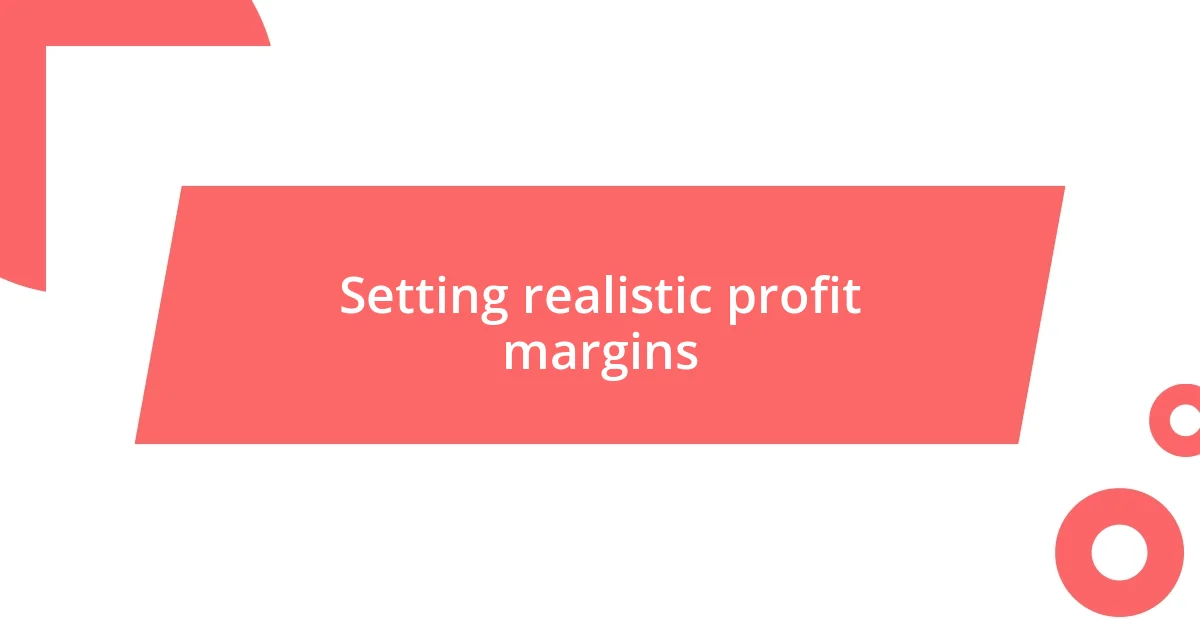Key takeaways:
- Setting realistic profit targets requires self-awareness, understanding market conditions, and aligning financial goals with personal values.
- Regularly monitoring and adjusting targets based on real-time market data helps mitigate risks and adapt strategies effectively.
- Reflecting on past performance, with a focus on emotional intelligence, can uncover valuable insights and improve decision-making in trading.

Understanding profit targets
When I first began setting profit targets, I found it quite daunting. I wondered, “How do I know what’s realistic?” Understanding profit targets requires not just an analysis of market conditions, but also a keen self-awareness of your own financial goals and risk tolerance. It’s about balancing ambition with practicality.
Setting a profit target means you’re not just aiming blindly; you’re creating a roadmap. I remember a time when I set a target too high without considering the volatility of the market. As a result, I felt the weight of disappointment when I didn’t hit it. Learning from that experience taught me the importance of being flexible and adjusting my targets based on real-time data rather than emotion.
Each profit target you set is essentially a mini-goal—an emotional checkpoint on your investment journey. Have you ever made a small gain feel monumental simply because you had a target in mind? I’ve felt that rush myself. It’s incredible how a clear target can transform your approach, turning trading from a guessing game into a structured plan that fuels your confidence and decision-making.

Defining your financial goals
Defining your financial goals is an essential first step in the profit targeting process. I remember when I first started; I had vague ambitions about “making money” without any specifics. It wasn’t until I sat down and articulated my exact objectives—like saving for a house or planning for retirement—that I truly grasped the power of clear financial goals. Having concrete goals provides a roadmap, guiding decisions and helping to maintain focus amidst market fluctuations.
When setting financial goals, it’s important to align them with your values and lifestyle aspirations. For example, after a few investments that didn’t yield the results I’d hoped for, I realized that my goals needed a personal touch. I shifted my focus from purely numerical targets to also considering how my investments would ultimately enrich my life experiences. This shift made my targets feel more meaningful and motivated me to stick to my plan.
Here’s a handy comparison table that can help clarify different types of financial goals:
| Goal Type | Description |
|---|---|
| Short-term | Goals aimed at achieving results within a year, like saving for a vacation. |
| Medium-term | Goals set for a period of 1 to 5 years, such as buying a car. |
| Long-term | Objectives planned for 5 years or more, like retirement savings. |

Analyzing market conditions
Analyzing market conditions is crucial when setting profit targets. I remember sitting with a trading chart open, engrossed in the fluctuating lines and patterns. The more I learned about market trends, the clearer my profit targets became. Recognizing factors like economic reports, news events, and seasonal trends made all the difference in shaping my strategy.
Here are a few key aspects to consider when analyzing market conditions:
- Volatility: Is the market swinging wildly, or is it maintaining stability? High volatility can mean both opportunity and risk.
- Trends: Are prices moving in an upward, downward, or sideways direction? Identifying the prevailing trend can guide your target setting.
- News Impact: How are recent news events influencing market dynamics? An unexpected event can have immediate effects that should not be ignored.
- Market Sentiment: Is the overall mood bullish (optimistic) or bearish (pessimistic)? Understanding how other traders feel can inform your targets.
- Support and Resistance Levels: What are the key price points where the market tends to bounce back or fall? These levels can serve as valuable indicators for setting realistic targets.
By recognizing these elements, I learned to adapt my profit targets accordingly. I vividly recall a time when I underestimated market sentiment during earnings season; my targets missed the mark as stock prices reacted impulsively to reports. This experience reinforced the need for an agile mindset when analyzing conditions—being overly rigid could easily derail my plans.

Assessing risk and reward
When I think about assessing risk and reward, I can’t help but recall the time I dove into my first investment without fully grasping the potential downsides. The excitement of a promising stock distracts from a crucial question: what am I willing to lose? Understanding this balance isn’t just about numbers; it’s about my comfort with uncertainty. Every time I set a profit target, I mentally weigh the expected rewards against risks, ensuring I’m not just chasing gains blindly.
There’s a real emotional component to this process too. I remember the anxiety that crept in during a downturn; suddenly, my targets felt like distant dreams. It made me realize that effective risk assessment requires a solid grasp of my own emotional responses. Are the potential rewards enticing enough to justify the stress of possible losses? This self-reflection doesn’t just guide my decision-making; it builds resilience against market swings.
Ultimately, I always ask myself, “What’s my risk tolerance?” It’s a sobering question that can steer my strategy significantly. Sometimes, I adjust my profit targets to ensure they align more closely with both my risk appetite and the market conditions I observe. This adaptability has often saved me from impulsive decisions that could have led to frustration and regret. How do you determine your risk versus reward in your investing journey? I’ve found that being honest with myself about my limits has made all the difference.

Setting realistic profit margins
Setting realistic profit margins involves a delicate balance, one that I grappled with early on. I vividly remember my first foray into a new investment; I had high hopes, fueled by excitement and a touch of naivety. I set an ambitious profit margin only to watch it slip away as I ignored market fluctuations. That experience taught me the hard way that aligning my profit expectations with market realities is essential for sustainable success.
I find that it’s critical to consider not just what I want to earn, but also what the market can realistically offer. During one particularly volatile period, I faced a situation where a stock I invested in began to rally, but I had set my profit margin too high. My desire for maximum gains clouded my judgment. Instead of adjusting my expectations based on the market’s behavior, I stubbornly held on. In the end, I missed an opportunity to profit simply because my targets were disconnected from what was achievable.
Reflecting on that, I now ask myself, “What constitutes a realistic margin in this specific context?” I start by analyzing historical price movements and competitive landscapes. This approach helps me develop a clearer picture of what’s feasible. Embracing imperfections in my profit expectations not only alleviates stress but fosters long-term growth. After all, a profit margin doesn’t have to be a lofty goal—sometimes, a steady, gradual climb can be much more fulfilling.

Monitoring and adjusting targets
Monitoring my profit targets is an ongoing process that truly shapes my trading strategy. I often revisit my targets, especially when market conditions shift dramatically. For instance, I once set a profit target during a bullish trend, but when a sudden downturn hit, I realized I needed to adapt quickly. The ability to reevaluate targets in real time allowed me to respond effectively to changing dynamics, preventing unnecessary losses.
Adjusting targets also requires a level of emotional awareness. I recall feeling the temptation to hold onto targets that felt safe during a recent investment. Despite knowing the market was turning, I hesitated to modify my target, clinging to the familiar. It was a lesson in recognizing when my emotions were driving my decisions, emphasizing the importance of staying objective and remaining flexible. Have I become too attached to a specific number? Yes, but acknowledging this helps me move forward with greater insight.
Lastly, I’ve found that incorporating regular check-ins with my performance is essential for continuous improvement. I use tools or a simple spreadsheet to track how my targets align with actual market behavior. By keeping a pulse on my trades and promptly adjusting my targets, I’m not just reacting; I’m fostering a proactive approach to my investments. Isn’t it fascinating how a few tweaks in strategy can lead to significant gains over time? This practice has enriched my understanding of the market and my own investing style.

Reviewing performance and strategies
I believe that regularly reviewing my performance is crucial for refining my strategies. I remember a particularly challenging period when I decided to dedicate a Sunday afternoon to analyze my recent trades. As I sifted through the data, I was surprised to see patterns emerge that I had previously overlooked. Was I too reactive to short-term fluctuations? Looking back, it’s clear that a long-term perspective could have prevented some missteps. This practice of reflection not only clarified my strengths and weaknesses but also ignited a desire to improve.
Emotional intelligence plays a significant role when evaluating my strategies. There was a time when I became overly confident after a string of successful trades; I thought I was invincible. However, as I reviewed my performance, I noticed that I was making reckless decisions, driven by a false sense of security. It was a wake-up call! I had to confront the reality of my ego, and it humbled me. Realizing that it’s not just about the numbers but also about understanding my own mental state has been a game-changer.
In a bid to remain objective, I often ask myself, “What would I advise a friend in my position to do?” This mental shift helps me detach from my emotions and focus on the facts. I recall discussing my strategies with a fellow investor over coffee. His insights about my tendency to chase losses were eye-opening. Why is it sometimes easier to see flaws in others’ strategies than in my own? This dialogue not only strengthened my accountability but also reminded me that collaboration can yield tremendous insights. So, during your review sessions, consider reaching out to trusted peers; their perspectives might just help illuminate blind spots in your approach.













